Logistics is considered one of the slowest industries to undergo digital transformation – only 28% of logistic companies in PWC’s Industry 4.0 study rated themselves as digitally advanced. In a McKinsey study, while that figure rose to 43%, it was still the lowest of five business areas they examined.
The uptake may be slow, but the need to significantly increase business efficiency by adopting technologies is fastly becoming apparent. In fact, PWC estimates with $4.6 trillion of revenue at stake, logistic companies need to digitize and adopt new and emerging technologies that will enable greater efficiency, lest they risk obsolescence.
But before we delve into what a digital transformation in logistics recruitment looks like, let’s take a look at the state of digital logistics presently.
What’s in?
State of digital transformation in the logistics industry
Over 70% of logistic businesses that have undergone a digital transformation say they have experienced an increase in their business because of it, by gaining better insights and being able to wield more control over their recruitment process, for example.
At the enterprise level, a full digital transformation means employing advanced technology to collect and process information automatically, feeding it into decision making, or using it to automate activities.
Even before the pandemic, logistic companies were investing in automation to make their processes more efficient and be more productive in meeting staffing needs. Utilizing technology in every aspect of logistics, from sensors to robotics, to IoT, to data analytics, revolutionizes a company’s operations, helping alleviate some of the strain brought about by rapid e-commerce growth.
Saying that, in a recent study, Capgemini Research Institute found that globally, $2 trillion will be spent on digital transformation technologies by the end of 2021, yet organizations are struggling to realize success with it.
This is supported by Siegmann et al. who showed that top-performing companies had higher engagement and more inclination to invest in new technologies, but according to DHL, 95% of companies are yet to realize the full benefits of a digital transformation.
Like what you see?
Don’t miss out. Subscribe to our quarterly digest to get the latest TA and TM resources delivered right to your inbox.
Digitization of recruitment in logistics
In the next 6 years, the logistics market is expected to reach $12,975.64 billion. This fast growth has led to an increase in the number of logistics roles that need filling, but combined with a high national unemployment rate yielding a higher-than-average number of applications for every open position, requires recruiters to ditch their old, traditional, manual recruitment processes in favour of a digital solution.
Yet one key blocker for digital transformation in logistics recruitment, is that many businesses are underutilizing the digital assets that are supposed to be helping them with talent acquisition and relying on old, inefficient, manual recruitment processes.
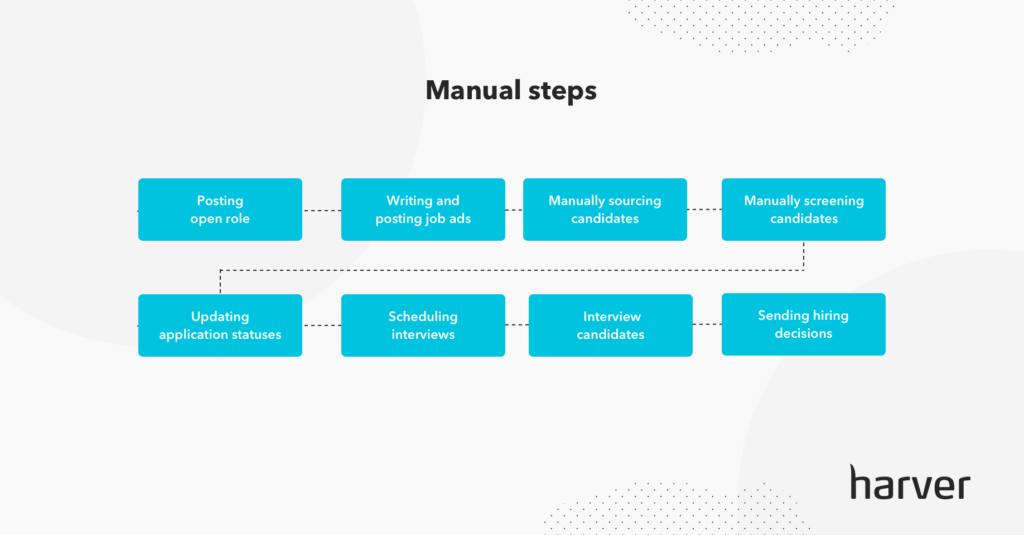
In tandem with spikes in customer supply and demand over the course of the last year, this makes it very difficult for companies to forecast their labor needs. Uncertainty around the ongoing pandemic, social distancing, and new safety precautions aren’t helping either.
The pandemic has forced certain steps of the hiring process to inadvertently undergo a digital transformation. For example, where a large portion of interviewing and onboarding of new employees, including drug screens, would have been carried out face to face, now these steps are largely digitized with virtual interviewing becoming the norm, digital candidate assessments being carried out remotely, and drug tests being conducted off-premise by third parties.
Recruitment marketing and direct sourcing remain largely traditional, manual processes, as does moving candidates along the stages of the recruiting funnel i.e. with recruiters screening resumes and scheduling interviews. Communications are also still largely carried out by people.
But these aren’t the only challenges holding back recruitment in logistics.
Challenges of volume hiring in logistics
Hiring in mass can feel daunting. When you’re trying to fill hundreds of positions at once, the typical challenges you face during recruiting are magnified.
In order to ensure you’re selecting the right candidates and efficiently bringing them through the recruitment process, you need to be properly prepared. That means understanding exactly how high volume recruitment is different from a traditional hiring process, as well as the unique challenges you’ll face.
Here are just a few of the challenges a high volume recruitment process can stir up.
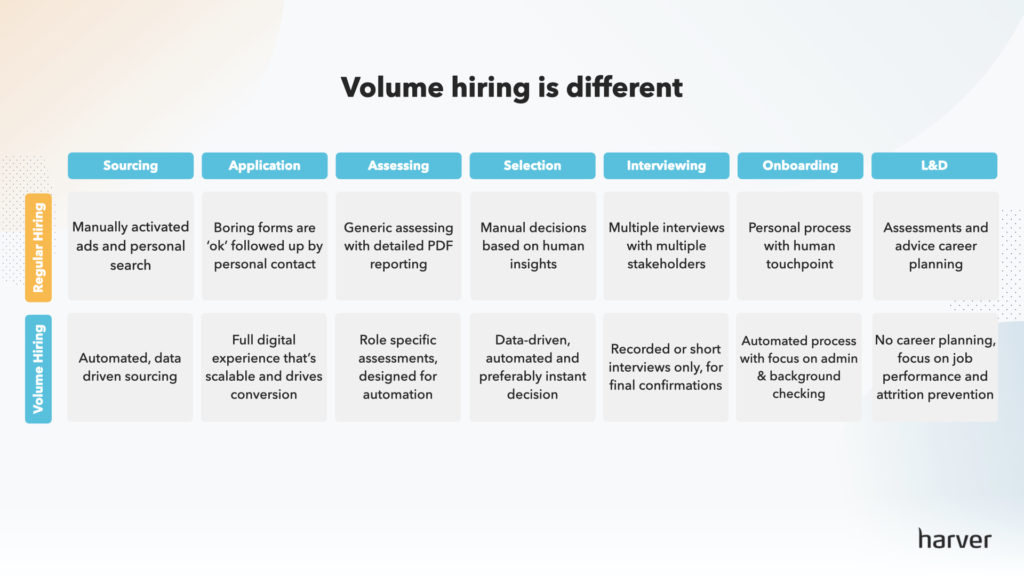
Attracting candidates
The image of logistics needs an overhaul – these low-complexity entry jobs just aren’t seen as attractive prospects. For most candidates, they’re not applying to get their foot in the door, to start along their career path. They simply want a job that will pay them, now, until they find something better, at which point they’ll jump ship.
Misaligned expectations
One key driver for early employee attrition is misaligned expectations. Usually explaining the intricate nature of a job, telling candidates what they might expect to do on a daily basis falls to the recruiter, someone who doesn’t have experience doing it first hand. When what the candidate thinks the role is going to entail doesn’t match with what the job actually is, they quit.
Finding candidates with the right skills
Just because you need to volume hire to fill roles, doesn’t mean you should hire just anyone who applies. There are certain skills that employees need to possess in order for them to be a good fit. When you hire poor quality candidates, the knock-on effect is tremendous: from low output to damaging team morale, low-quality employees who don’t possess the requisite skills cost you not just in monetary terms, but they damage your reputation too, stymying your ability to hire well in the future.
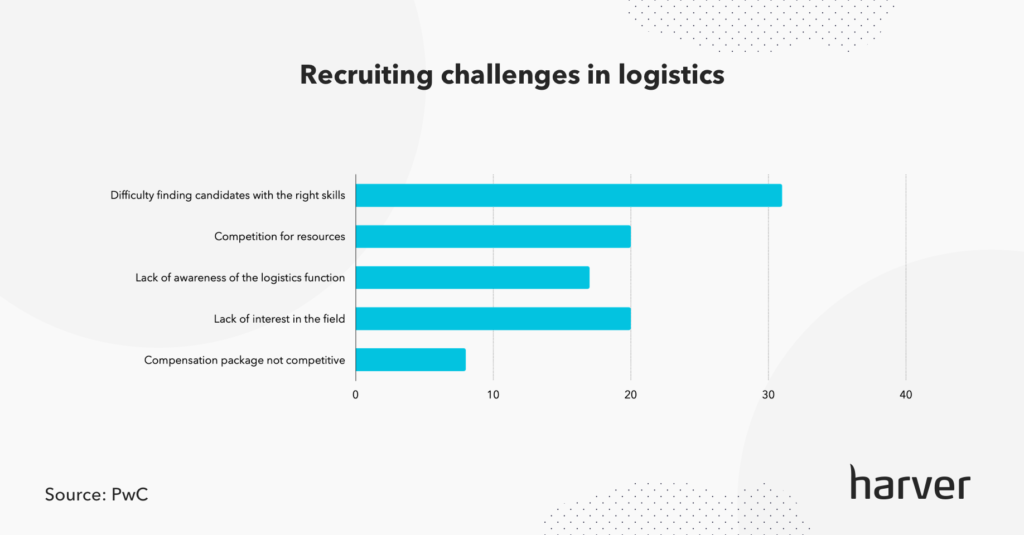
Assessing each candidate while staying efficient
Manual recruitment relies on recruiters screening every resume and assessing each candidate individually. Not only is this a lengthy process, but it encourages bias into the hiring decision because talent acquisition leads base their decision on a candidate’s resume (if they have one) and past experience. And past experience is not a predictor of future success.
Showcasing company culture
Logistics is a people-heavy industry, meaning if you hire employees who don’t fit with your culture, who don’t share your values, they aren’t going to last, and if they do, they’ll cause untold damage to your culture.
Candidates don’t apply with CVs
For low-complexity entry jobs, the majority of applicants are either new to the industry and don’t have a resume, or if they do, their experience is in a different industry. Plus, for the majority of applicants, they’re looking for a job, now, they don’t want to go through lengthy applications. In fact, we’ve found that the longer the application, the higher the applicant dropout rate.
Stop guessing,
Start data-driven hiring.
Learn how you implement a modern candidate selection process, that is: streamlined, experience-driven and backed by data.

Solutions for tackling these challenges
We’ll look at the practical solutions for tackling these challenges in the next section, but first, let’s explore this topic from a higher level, and get the big picture. In principle, these are the things an organization can do to solve the challenges of volume recruitment in logistics:
Optimize sourcing
Determining which sourcing channel yields the highest quality leads, not just the one that yields the most leads, is key when volume hiring. By looking at your sourcing channels and performance data of new hires, will you get a better understanding of applicant volume and stage progression, as well as a good understanding of where your top-performing employees have come from. This helps you focus your sourcing efforts where you can make the most impact.
Showcase company culture
Incorporate videos during the application process to showcase company culture and help prevent attrition. Combine realistic job previews with situational judgment tests to show candidates what they might expect on a daily basis while assessing them for the necessary skills to perform the role well.
We’ve detailed the topic of realistic job previews below.
Pre-employment assessments
Define beforehand what makes a good hire, and use it as a benchmark to assess applicants against to make sure you hire better. Assess candidates for skills, not based on past experience or what a resume says. Pre-employment assessments can help you narrow down your pool of applicants to those who possess the predefined skills and characteristics that are indicative of top job performance.
Manage expectations
Mitigate against early attrition by aligning expectations from the off. During the application process, provide realistic job previews to allow applicants the opportunity to filter themselves out of the process if they don’t like what they see.
Candidate experience
Just because you’re volume hiring doesn’t mean the digital experience should equate to impersonal. Providing a quick candidate experience that’s informative and engaging, will increase completion rates.
Don’t forget to measure the level of candidate satisfaction to keep track of the general sentiment of your talent pool, ask for feedback early in the process so you get feedback from as many applicants as possible, not just the people who get hired. Using our experience insights dashboard can help you keep a finger on the pulse of candidate experience.

Digital transformation framework – how all the solutions come together
Now, knowing how to solve these challenges doesn’t help you if you don’t see how all these solutions come together in a coherent, digital-first strategy. The trap here is that you might start to invest randomly in recruitment tools, digitizing the areas you find most troublesome. However, undergoing a partial digital transformation isn’t sufficient to help solve hiring challenges in logistics.
A digital transformation framework in logistics recruitment means taking a holistic approach and identifying the technology that will allow your company to deliver an outstanding candidate experience, automate your recruitment processes, increase hiring efficiency, reduce costs and make fair, data-driven hiring decisions.
In order to carry out data-driven recruitment, companies not only have to acquire and use data capturing technologies, but they also need to analyze the data generated to extract value from it and use it to make good hiring decisions.
Harver is an end-to-end, digital recruitment solution that integrates into your existing tech stack to fully automate your hiring process, make it faster, better, and without bias.
We’ve uncovered four major areas of technology that will help you digitize your recruitment function in a structured and scalable manner.
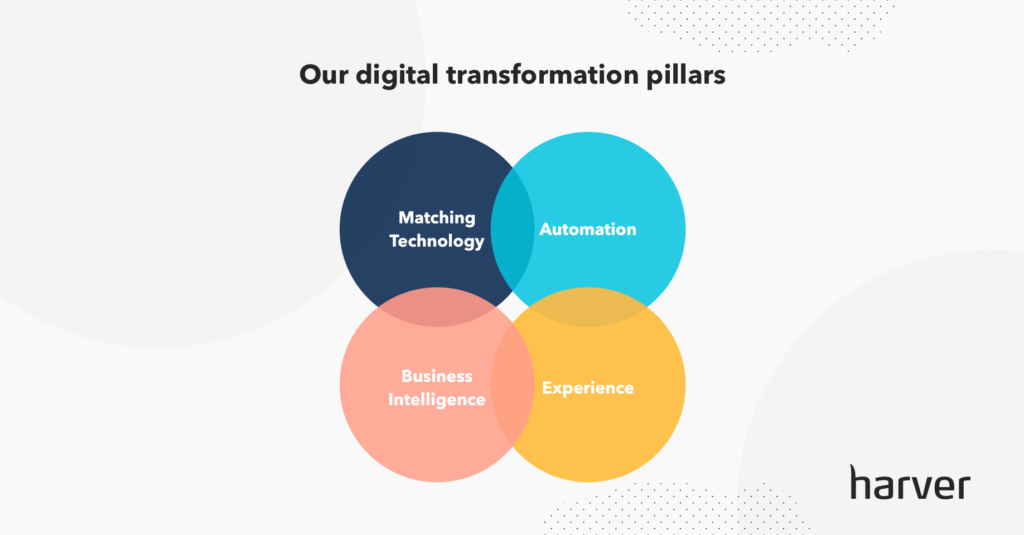
Matching technology
No matter the organization or role, there are always skills and competencies that predict success on the job. To hire at scale, you should be systematically screening candidates for the characteristics that predict success in your specific organization. Matching technology is built exactly for this purpose: to help you evaluate candidates at scale, across multiple competencies that are relevant for your open roles and predictive of success on the job.
Matching technology does the hard work for you by assessing candidates, scoring their skills and competencies, and moving applicants forward in the recruitment process if they meet specific selection criteria. This helps recruiters make objective, data-driven decisions about candidates, while ensuring a high quality of hire.
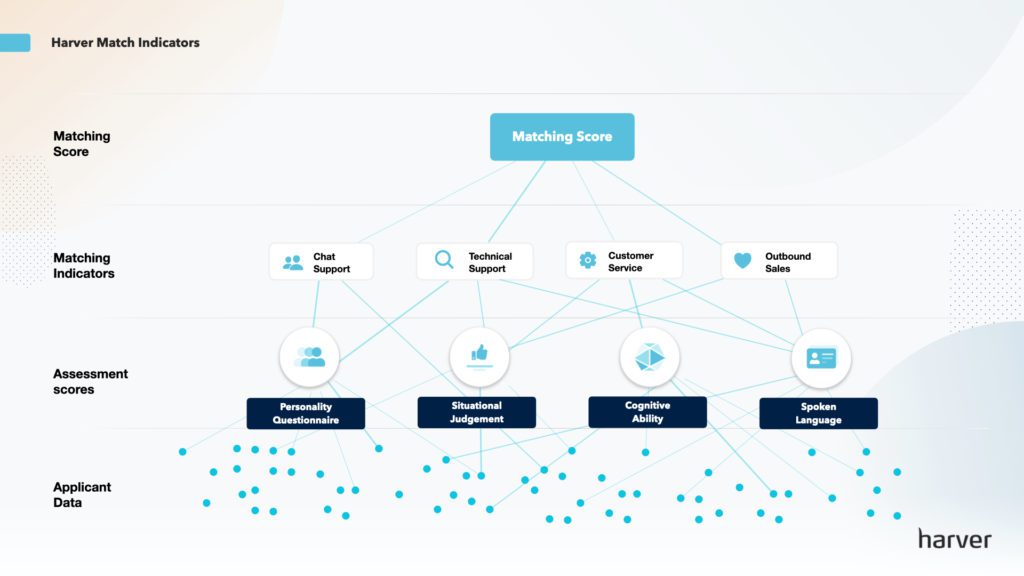
The details of matching technology implementation might vary from one organization to another, in the sense that each position or job family might require custom, role-specific pre-employment assessments that measure not only a set of hard and soft skills but also a candidate’s organizational fit.
But in general, talent matching technology relies on pre-employment assessments used to identify candidates with the skills and disposition to be a top performer in a specific role.
We’ve detailed the framework used by Harver, called two-way matching, in the article below.
Automation
Having bad hiring processes doesn’t just mean you’re hiring inefficiently, you’re also wasting recruiters’ time by having them carry out manual tasks that can so easily be done by technology. Speed up your workflows and move candidates quickly and efficiently through your hiring funnel, while filtering out those that are a poor fit.
An automated, fast workflow equates to fewer lost candidates, lower costs, and higher quality of hires. In fact, nearly every stage of the recruitment process can be automated. The only steps that can’t are the ones that need human input: interviewing and making a hiring decision. The rest of the time, you have an agile process that can scale up or down to meet demand, removing inefficiencies from your hiring funnel.

Candidate experience
With matching technology and automation in play, candidate experience is outstanding. They not only get a more informative experience for the role they’re applying to, but they also have the power to remove themselves from the process if they don’t like what they see, before wasting anyone’s time at an interview, or accepting a job and then quitting.
For entry-level roles, the candidate journey has to be short, engaging, and provide a good overview of what to expect, while simultaneously assessing applicants for the necessary skills that will make them a good fit. Asking candidates for feedback during and at the end of the process allows you to monitor the general sentiment in the talent pool, it also shows you which stages are causing the most drop-offs.
Business intelligence
The final pillar of our digital transformation framework is Business Intelligence. Because in order to take advantage of a data-driven recruitment process, you have to be able to extract insights easily.
Our platform offers you these insights through an array of out-of-the-box dashboards such as Sourcing Insights, or Candidate Experience Insights, even Bias Insights, we can also build bespoke dashboards if you need to track certain KPIs.
You can learn more about our BI solution below.
Next steps
Our world is changing so quickly and technology is constantly evolving, businesses need to remain agile and be data led in order to stay ahead. Undergoing a digital transformation is essential for logistics businesses – it will revolutionize recruitment for your organization.
Our platform brings together people science and data science, providing you with actionable insights to enable you to:
- Source better
- Automate your hiring process
- Create a more streamlined recruitment strategy
- Reduce your costs
- Make your hiring more efficient
- Reduce employee attrition
- Scale hiring up or down as necessary
- Provide insights into candidates and your process
- All the while finding you the best talent even when volume hiring
If you’d like to find out more about how Harver can help you adopt a digital-first recruiting strategy and digitally transform your logistics recruitment, book a demo below.
Ready to transform your hiring process?

